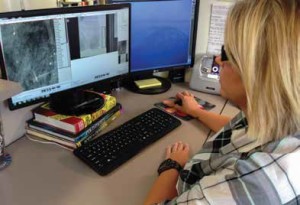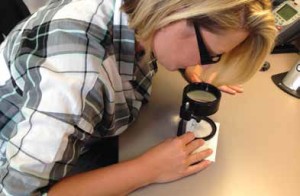The Right Match: Software Enhances Fingerprint ID Process

CERTIFIED LATENT PRINT EXAMINER LEEANN WHITNEY CONDUCTS A SIDE-BYSIDE COMPARISON OF TWO FINGERPRINTS USING A COMPUTER SOFTWARE CUSTOM DESIGNED FOR FORENSIC IMAGING. THE CCSO ID SECTION RECENTLY STARTED USING THE SOFTWARE, WHICH HELPS SPEED UP THE IDENTIFICATION PROCESS. PHOTOS BY CPL. EFRAIN HERNANDEZ/CCSO (2)
A 17-year-old Golden Gate girl awoke to find a strange man in her bedroom last December.
The girl asked the man why he was there. Startled, he scurried out of her room, ran downstairs and out the house.
The girl and her family told Collier County Sheriff’s Office detectives they had no idea who would break into their house.
Detectives had no leads. Within two weeks detectives had a suspect, thanks to fingerprint evidence found at the scene.
Fingerprinting is one of the most important ways law enforcement identifies criminals, and the faster the better. Recent technology is helping CCSO get the job done more efficiently than before.
Traditionally, fingerprint examiners conducted an examination using a small magnifier called a loupe to view minute details, known as minutiae, of a print. A pointer called a ridge counter was used to count the friction ridges. In addition, CCSO fingerprint examiners are now using a computer software program that helps speed up the identification process.
The CSIpix software lets fingerprint examiners quickly compare two detailed prints side-by-side at the same scale on a computer monitor. The software is custom designed for forensic imaging with functions like autoscale and synchronized zooming plus comprehensive annotation tools and standard enhancement features. It can significantly speed up the processing, calibration, comparison, and annotation of fingerprints and other forensic images.

TO CONDUCT AN EXAMINATION, FINGERPRINT EXAMINERS ALSO USE A SMALL MAGNIFIER CALLED A LOUPE TO VIEW MINUTE DETAILS, CALLED MINUTIAE, OF A PRINT
Fingerprints are the little ridges on the end of your fingers and thumb. They are arranged in patterns of loops, whorls, and arches. No two people have exactly the same fingerprints. Even identical twins, with identical DNA, have different fingerprints.
Fingerprint examination involves looking at the quality and quantity of information in order to find agreement or disagreement between the unknown print from a crime scene and known prints on file.
After the Golden Gate break-in, Crime Scene investigators processed the house for evidence. A latent fingerprint was taken off the bedroom door handle. The ID Section took the print and ran it through the Automated Fingerprint Identification System (AFIS), a computer database that stores and retrieves fingerprint images. The print was searched against a database of millions of individual fingerprints. Within minutes, the AFIS returned information on the 25 closest matches to the print searched. Using the software, Certified Latent Print Examiner LeeAnn Whitney did a side-by side comparison on the computer of the print from the door handle to the first print received from AFIS to determine if there were similarities.
“Right off the bat those two (prints) looked very similar to me, just the overall pattern type,” Whitney recalled.
She also examined the print for minutiae characteristics and locations which make each person’s prints distinctive.
Satisfied there was enough information in both prints to match, Whitney called on another trained examiner to give her assessment. Latent Print Examiner II Tammy Taylor verified the print was a match. Detectives arrested an 18-year-old Golden Gate man and charged him with burglary. The young man attended the same high school as the victim.
The CCSO ID Section examines all fingerprint evidence collected in CCSO cases. Other, more complicated evidence, such as DNA, is sent to the Florida Department of Law Enforcement lab for examination.
Examining fingerprint evidence onsite allows for a more timely result compared to submitting prints to a lab, which can take weeks, said Lt. Scott Barnett, who has supervised the ID Section for the past 25 years.
“When we go to the AFIS and put these prints in we’ve actually called detectives back the same day and told them who the bad guy is,” Lt. Barnett said.

Leave a Reply
Want to join the discussion?Feel free to contribute!